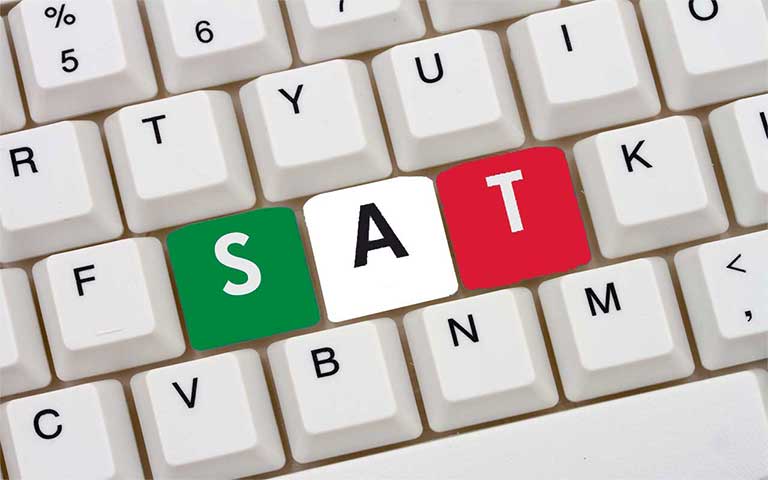Master Punctuation of Supplements in Digital SAT Grammar

Home > digital SAT course > boundaries > supplements
In digital sat grammar, you need to know the punctuation of supplements for some standard English convention questions. Here are 5 example questions and how to answer them.
- supplements explained
- supplements SAT practice with how to answer
- FAQ supplements
key takeaways
There are 2 simple rules to answer the SAT supplement questions:
- Read the text, does it need any punctuation to separate some part? If not then choose the option without any punctuation
- If there is a part that is not needed and is just additional information, separate it using the same punctuation mark (e.g. comma, dash, bracket)
PART 1: SUPPLEMENTS EXPLAINED
What are Supplements?
Supplements are words, phrases, and relative clauses that add extra information to a sentence. There are two types of supplements: essential and not essential.
For example:
- Essential: In a basketball game, the team that scores the most points will win.
- Not essential: The basketball team, which won the state championship last year, got on the bus
Supplement Punctuation
No punctuation
- If the sentence no longer makes sense, then the supplement is essential. No punctuation should be used.
Use punctuation
- If the sentence still makes sense, then the supplement is not essential. The supplement must be separated from the rest of the sentence by punctuation.
- Commas (,)
- Parentheses ()
- Dashes (—)
- the same type of punctuation must appear before and after a nonessential element.
Single or Double Punctuation
Single punctuation
- If the supplement begins or ends the sentence, it only requires a comma
- A striker with 62 goals in international play, Megan Rapinoe is known for her activism in addition to her soccer stardom.
Double punctuation
- If the supplement comes in the middle of the sentence, it requires punctuation on both sides.
- Megan Rapinoe, a striker with 62 goals in international play, is known for her activism in addition to her soccer stardom.
In the SAT test
- the choices add or remove commas, but not conjunctions
- the choices include multiple types of punctuation, like commas and dashes
PART 1: SUPPLEMENTS EXPLAINED
How to Use Punctuation for Supplements to Answer Example SAT Questions
Nonessential elements can be separated from the rest of a sentence using three different types of punctuation marks:
- Commas (,)
- Parentheses ()
- Dashes (—)
Choose these or no punctuation in these types of questions.
SUPPLEMENTS QUESTION 1
Chef Dominique Ansel created the “cronut”, a cross between a croissant and a donut in New York in 2013.
Choose 1 answer:
- A NO CHANGE
- B donut,
- C donut—
- D donut;
HOW TO ANSWER SUPPLEMENTS QUESTION 1
The nonessential element starts with a comma so the second comma is needed, seen in the correct answer B.
SUPPLEMENTS QUESTION 2
The pyramids, that are located in present-day Sudan, were constructed by rulers of the ancient Kushite Empire to serve as tombs for the most powerful citizens.
Choose 1 answer:
- A NO CHANGE
- B pyramids, that are located in present-day Sudan)
- C pyramids that are located in present-day Sudan
- D pyramids—that are located in present-day Sudan—
HOW TO ANSWER SUPPLEMENTS QUESTION 2
It looks at first like we have two commas, so A could be the answer. But if you read the sentence correctly you can see all the text is part of the sentence so there is no punctuation, so C is the answer.
SUPPLEMENTS QUESTION 3
Gouldian finch chicks (thanks to phosphorescent beads on the edges of their mouths – are easy to feed in the dark.
Choose 1 answer:
- A NO CHANGE
- B mouths
- C mouths)
- D mouths,
HOW TO ANSWER SUPPLEMENTS QUESTION 3
Here is a good example of the extra text part, the nonessential element. We don’t have matching punctuation though with a bracket and dash. So we can find the answer with a simple match of the first bracket, so C is the answer.
SUPPLEMENTS QUESTION 4
The person (taking passport photos) will ask you to remove your glasses and maintain a neutral expression.
Choose 1 answer:
- A NO CHANGE
- B person, taking passport photos,
- C person taking (passport photos)
- D person taking passport photos
HOW TO ANSWER SUPPLEMENTS QUESTION 4
If you read the sentence you can tell that there is no need for any punctuation, so D is the answer.
SUPPLEMENTS QUESTION 5
The Great Boston Molasses Flood of 1919, which moved faster than one would expect, killed 21 people and injured 150.
Choose 1 answer:
- A NO CHANGE
- B 1919, which moved faster than one would expect—
- C 1919 which moved faster than one would expect
- D 1919 which moved faster than one would expect,
HOW TO ANSWER SUPPLEMENTS QUESTION 5
Again, a simple use of two commas to separate an element in the middle of the sentence. A is the answer.

9 LESSONS
Digital SAT English
gain a clear understanding of the question types, structure, and strategies.
feel ready to use official SAT resources effectively because you will know what to look for and how to approach questions.
They are equipped with essential information, knowledge and strategies to confidently attempt SAT-level practice questions and eventually full tests — transforming from beginners to focused SAT learners.
1
- (Choice A, Incorrect) This choice creates a punctuation error. “A cross between a croissant and a donut” is a nonessential element that should be set off from the rest of the sentence with punctuation on either side.
- (Choice B, Checked, Correct) This choice effectively uses commas to set off the phrase “a cross between a croissant and a donut”, which is a nonessential element that should be set off with punctuation.
- (Choice C, Incorrect) This choice creates a punctuation error. “A cross between a croissant and a donut” is a nonessential element that should be set off from the rest of the sentence with matching Notice that the dash in this choice doesn’t match the comma used earlier in the sentence.
- (Choice D, Incorrect) This choice creates a punctuation error. “A cross between a croissant and a donut” is a nonessential element that should be set off from the rest of the sentence with matching Notice that the semicolon in this choice doesn’t match the comma used earlier in the sentence.
2
- (Choice A, Incorrect) This choice incorrectly sets off “that are located in present-day Sudan”, which is essential to the sentence.
- (Choice B, Incorrect) This choice incorrectly sets off an essential element with punctuation. The punctuation used (a comma and a parenthesis) is also mismatched.
- (Choice C, Checked, Correct) This choice correctly avoids punctuating the phrase “that are located in present-day Sudan”, which is an essential element that should not be set off with punctuation.
- (Choice D, Incorrect) This choice incorrectly sets off “that are located in present-day Sudan”, which is essential to the sentence.
3
- (Choice A, Incorrect) This choice creates a punctuation error. “Thanks to phosphorescent beads on edges of their mouths” is a nonessential element that should be set off by matching Notice that the dash used in this choice doesn’t match the open parenthesis at the start of the phrase.
- (Choice B, Incorrect) This choice creates a punctuation error. “Thanks to phosphorescent beads on edges of their mouths” is a nonessential element that should be set off by matching punctuation.
- (Choice C, Checked, Correct) This choice effectively uses parentheses to set off the phrase “thanks to phosphorescent beads on edges of their mouths”, which is a nonessential element that should be set off with punctuation.
- (Choice D, Incorrect) This choice creates a punctuation error. “Thanks to phosphorescent beads on edges of their mouths” is a nonessential element that should be set off by matching Notice that the comma used in this choice doesn’t match the open parenthesis at the start of the phrase.
4
- (Choice A, Incorrect) This choice incorrectly sets off “taking passport photos”, which is essential to the sentence.
- (Choice B, Incorrect) This choice incorrectly sets off “taking passport photos”, which is essential to the sentence.
- (Choice C, Incorrect) This choice incorrectly sets off “passport photos”, which is an essential element.
- (Choice D, Checked, Correct) This choice correctly avoids punctuating the phrase “person taking passport photos”, which is an essential element that should not be set off with punctuation.
5
- (Choice A, Checked, Correct) This choice effectively uses commas to set off the phrase “which moved faster than one would expect”, which is a nonessential element that should be set off with punctuation.
- Choice B, Incorrect) This choice creates a punctuation error. “Which moved faster than one would expect” is a nonessential element that should be set off by matching Notice that the dash and comma in this choice don’t match.
- (Choice C, Incorrect) This choice creates a punctuation error. “Which moved faster than one would expect” is a nonessential element that should be set off from the rest of the sentence with punctuation.
- (Choice D, Incorrect) This choice creates a punctuation error. “Which moved faster than one would expect” is a nonessential element that should be set off from the rest of the sentence with punctuation on both sides.
FAQ Punctuation of Supplements: Grammar, Commas, Colon and More
What is supplementary information in a sentence?
Supplementary information explains or adds detail to the main idea. It may or may not be present in the statement and is considered a nonessential modifier.
What punctuation is used to enclose supplementary information?
Commas, dashes, and parentheses are used to enclose explanatory information that may clarify a sentence but is not required for it to be a complete sentence.
How do you identify the punctuation mark used to supplement words?
Look for punctuation used to separate or indicate extra information. This includes commas around a phrase, dashes used to indicate emphasis, or parentheses used to enclose notes.
Does supplementary punctuation affect the meaning of a sentence?
The punctuation does not affect the core meaning or the code number assigned in most cases. It adds detail without altering the main point.
What are guidelines for punctuating modifiers and supplements on the SAT?
If the phrase is considered a nonessential modifier, use punctuation to show it is separate from the main sentence. Always identify the punctuation mark that fits the guideline.
More Grammar and Punctuation Practice
On the SAT, you may see a list with explanatory information inside it. You must check if the punctuation mark used is correct. Quotation marks are not used for supplements unless quoting speech or a title.
A hyphen is used to connect parts of a compound word, not to enclose extra phrases. Commas, dashes, or parentheses are used to supplement words or explanatory information that may or may not be present.
If you have any confusion, remember the goal is clarity. A supplement is present in the statement to clarify meaning, but the sentence should still be correct without it.
In summary, use punctuation that follows the rules and does not change the main idea. Check if the phrase is considered a nonessential part and select the punctuation that clearly shows this.
